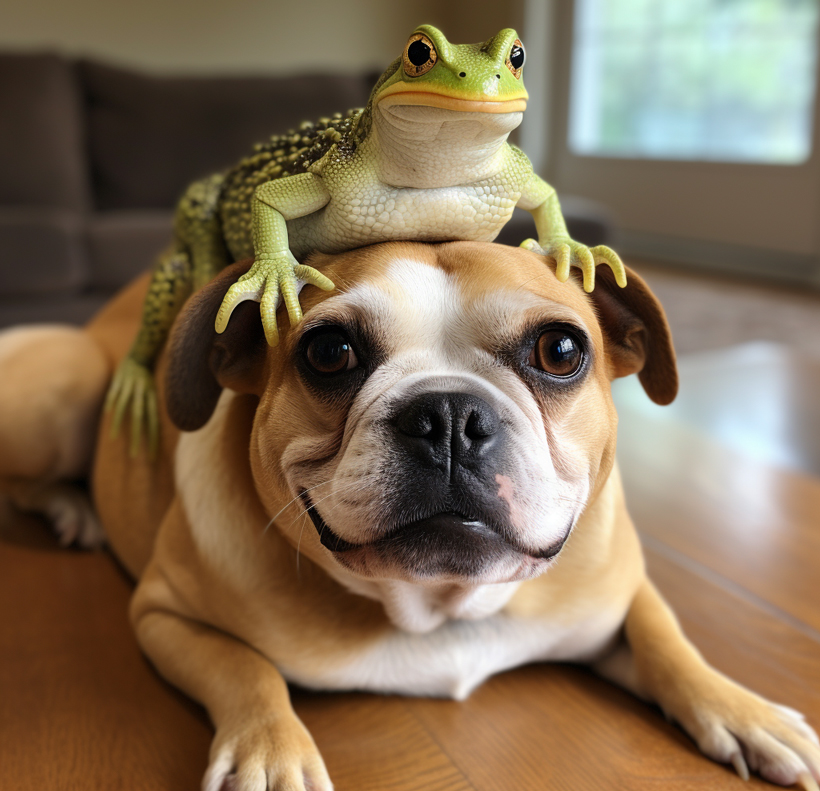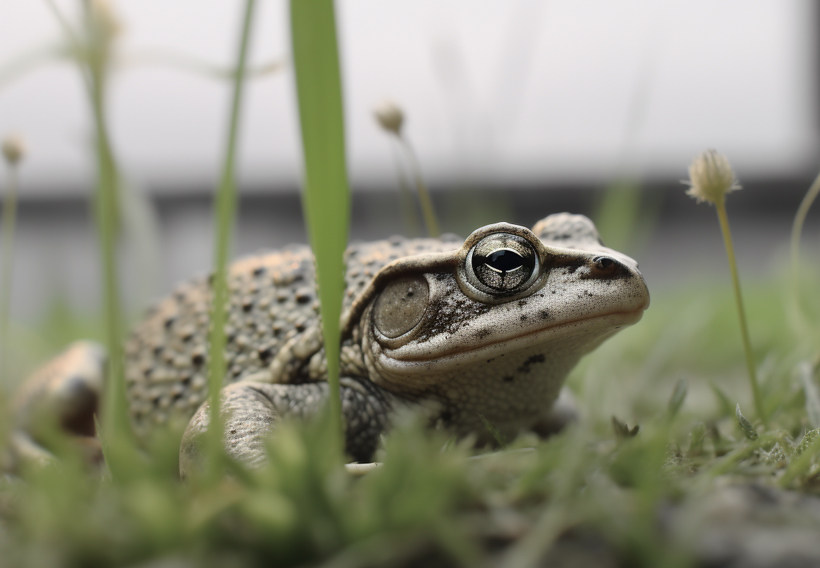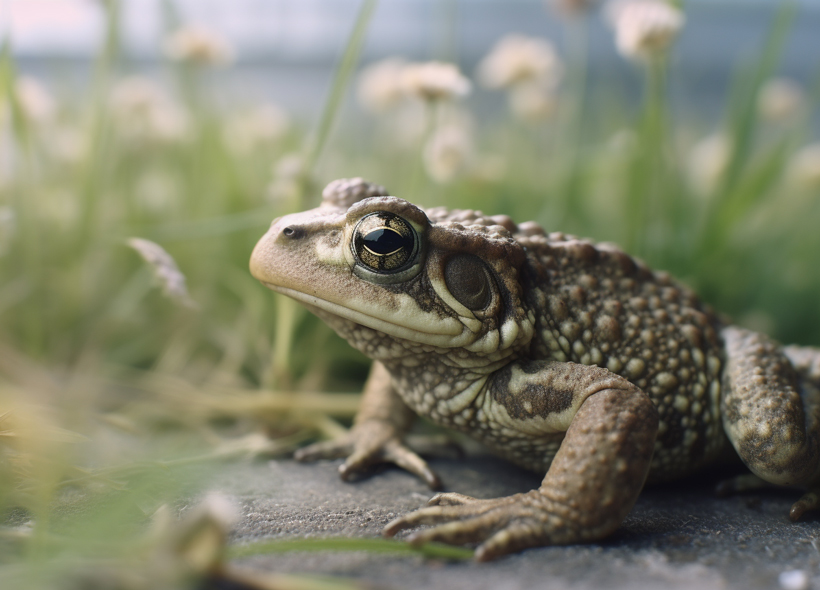Unlike humans, our pet dogs can’t differentiate between what’s safe to consume. Thus, from poisonous frogs to other toxic substances they can eat, it causes consequences like vomiting.
So, what happens if a dog eats a frog and is vomiting? If a dog eats a toxic frog, it can lead to poisoning. The other symptoms may include excessive drooling, red gums, diarrhea, and other gastrointestinal issues.
In this article, you will find an in-depth expert guide with the best solutions to treat your dog after it has ingested a frog. By reading further, you will gain valuable insights to provide appropriate care for your beloved pet without worsening the situation.
What Happens If a Dog Eats a Frog and Is Vomiting? The Consequences
Frog poisoning in dogs can occur when a dog ingests a poisonous frog species. The toxins in some frogs can affect a dog’s heart and neurological system, leading to tremors and more fatal consequences.

Here are the consequences that can happen if your dog eats a poisonous frog and then vomits.
- Heart problems: They can have heart problems due to the reaction to the poisonous chemical. It might not be an instant issue, but you can face it within an hour or so in severe cases.
- Nervous system issue: According to a report published by the University of California, This happens by reaction with the nervous system, which may cause your dog to panic or misbehave.
- Other Adverses: If left untreated, Vomiting can lead to weight loss, dehydration, and malnourishment. Most importantly, the adverse effects will only stay longer if you keep your dog untreated.
However, dog owners must be able to identify the symptoms of frog poisoning to take prompt action.
Can Consuming a Poisonous Frog Kill My Dog?
Consuming a poisonous frog can be highly dangerous for dogs and potentially result in death. In most cases, the situation can be controlled with proper medications. So, whether eating poisonous frogs would kill your dog highly depends on your actions and fate, of course.
Poisonous frogs produce toxins, such as bufotenin, that can seriously affect a dog’s health. If your dog ingests a poisonous frog, these toxins can quickly spread through its body, causing adverse reactions.

Moreover, the severity of the reaction can depend on factors like the size of the frog, the amount consumed, and the specific toxins involved.
Remember that the dog may require hospitalization and intensive care in severe situations. If you suspect your dog has eaten a frog and is vomiting, it’s essential to seek veterinary assistance immediately to prevent any serious consequences.
Identifying Frog Poisoning in Dogs
Here are some common signs to watch to understand if your dog ate a frog.

Excessive Drooling and Foaming at the Mouth: Excessive drooling and foaming at the mouth are often initial signs of frog poisoning in dogs.
- Gastrointestinal Distress: Frog toxins can lead to gastrointestinal symptoms such as Vomiting and diarrhea.
- Redness and Swelling: Frog toxins can sometimes cause redness, inflammation, and swelling around the dog’s mouth, lips, or gums.
- Changes in Behavior and Motor Skills: Frog poisoning can also affect a dog’s behavior and motor skills. Common signs may include disorientation or difficulty walking.
Toxic Frogs to Watch Out for When Keeping Your Dog Safe
Knowing which species of frogs are harmful to dogs is crucial if you own a dog. All frog species are not dangerous, but some can release toxins that your defenseless pets can’t tolerate.

Here is a list of poisonous frogs to avoid when protecting your dog:
1. Toads of the Colorado River (Incilius alvarius)
Sonoran Desert toads, also known as Colorado River toads, are widespread in northern Mexico and the southwest United States. These frogs are olive green to dark brown in color and size between 3-7 inches.
Behind their eyes, these toads have glands that release a poisonous chemical when threatened. This poison may harm an animal’s central nervous system and result in unconsciousness, seizures, or even demise.

2. Cane Toad (Rhinella marina)
Bufo toads, often called cane toads. You can identify these frogs by their gray, olive, yellow-brown, and red-brown colors. With an average size of 9-13 cm, they originated in South and Central America, and sections of the southern United States have now been exposed to them.
If these toads are consumed, they can be very dangerous to dogs. The poisons attack the cardiovascular system, resulting in erratic breathing, convulsions, and an irregular heartbeat.

3. Toxic dart frogs (Dendrobatidae)
Brightly colored poison dart frogs, commonly called dart-poison frogs, are native to Central and South America. Interestingly, these frogs come in various colors including yellow, green, blue, red & black. They have an ideal size of 1-2 inches.
Despite their diminutive size, these frogs are incredibly toxic and, if consumed by a dog, can result in paralysis or even death. Most notably, the toxins in dart frogs can cause cardiac arrest, respiratory problems, convulsions, and impairment of muscle function.

4. Green Tree Frog (Litoria caerulea)
There are green tree frogs in South Asia, Australia, and North America, among other places. Such frogs grow up to 11 inches in body length. Some green tree frogs can hurt dogs, but not all are poisonous.
Green frogs with white spots are more toxic. They typically release toxins through their skin, which might result in gastrointestinal symptoms like Vomiting, diarrhea, and others.

However, other types of toxic frogs are harmful. If you and your pet live in river-centric areas or beside borders, you should also know more about other harmful insects for your dog.
Toads Vs. Frogs: Understanding the Difference and Harmfulness to Dogs
Toads and frogs are distinct species. They have their unique characteristics and behaviors. Understanding these two groups’ differences regarding toxicity and harm to dogs is essential.

Here is a comparison and information on the different frogs’ harmfulness to dogs:
| Characteristics | Frogs | Toads |
|---|---|---|
| Physical state | Slimy skin, longer hind legs, tend to be leaner. | Dryer, warty skin, shorter hind legs, tend to be stockier. |
| Habitat | They are more commonly found near water sources, ponds, and wetlands. | It can be found in various habitats, including drier environments. |
| Toxicity Level | Some species of frogs secrete toxins that can harm dogs. | Many species of toads secrete highly toxic substances. |
| Harm to Dogs | Ingesting certain species of frogs can cause mild to moderate toxicity. | Ingesting certain species of toads can cause severe toxicity. |
| Dangers For Dogs | Symptoms such as gastrointestinal upset and skin irritation. | Including excessive drooling, vomiting, seizures, and even death. |
While certain species of frogs may produce mild toxins, it is less common for frogs to be highly toxic. Most frogs do not possess toxic glands like toads do. Therefore, the level of toxicity from frogs is generally lower, and cases of severe poisoning in dogs from frogs are rare.
Emergency: My Dog Ate a Frog and is Foaming at the Mouth. What to Do?

If your dog has ingested a frog and is now foaming at the mouth, it is crucial to act quickly.
First, safely remove any remaining frog from your dog’s mouth. However, do not put your fingers in their mouth if they have difficulty breathing or are aggressive.
Next, contact your veterinarian or local emergency animal hospital immediately. They can guide you on what steps to take. They may ask you to monitor your dog’s vital signs and route to their facility for guidance.
Home Remedies to Cure the Effects of Dog-Eating Frogs
Severe cases of dog-eating frogs can lead to various adverse effects on our furry friends. Therefore, seeking veterinary care for such patients is crucial. But before seeking medical help, you should ensure some primary treatment to manage the issue before going for medical treatment.

However, some home remedies can help ease the effects. Here are a few proven remedies you can try:
Mouth Rinse
If the frog’s toxin has come into contact with your dog’s mouth, prepare a mixture of one part hydrogen peroxide diluted with three parts water.
Gently swish the solution around your dog’s mouth for a few seconds. During this, ensure they don’t swallow it.
Then, Rinse their mouth thoroughly with water afterward.
Activated Charcoal:
Administering activated charcoal can help absorb any remaining toxins in your dog’s system. Consult your veterinarian to understand the appropriate dosage based on your dog’s weight. Mix the prescribed amount of activated charcoal with water or a pet-safe liquid and give it to your dog as instructed.
Soothing Baths
Some dogs may experience skin irritation or itchiness after exposure to the toxicity. In this case, give your dog a relaxing bath using hypoallergenic or oatmeal-based shampoos to relieve these symptoms. Keep in mind to avoid using harsh detergents or human-grade products.
Please remember that these remedies are suggested for mild cases. It would be best if you did not replace professional veterinary care.
Essential Do’s and Don’ts When Treating Your Dog After Eating a Frog

When your dog has ingested a frog and is experiencing symptoms such as foaming at the mouth, there are several do’s and don’ts to keep in mind:
Do’s:
Evaluate the situation: It’s critical to act swiftly if your dog exhibits indications of discomfort or has trouble breathing.
Contact a veterinarian immediately: Contact a nearby emergency animal hospital or your usual veterinarian.
Keep an eye on your dog’s actions: Keep an eye on your dog’s health indicators, such as breathing, heart rate, and general behavior.
Maintain your dog’s comfort and peace: Limit physical exertion and offer a peaceful, suitable environment.
Don’ts:
- Do not panic. While concerned, panicking will only worsen matters.
- Only attempt to influence Vomiting with professional advice. Inducing Vomiting may not be recommended depending on the specific situation and frog species.
- Only use medicines with professional consultations.
- Avoid delays. Waiting for symptoms to resolve independently can lead to more severe complications.
Remember, while these dos and don’ts provide general guidelines, consulting with a veterinarian for accurate and tailored advice based on your dog’s specific situation is crucial.
How to Prevent My Dogs From Eating Frogs?
You know that prevention is better than cure. Therefore, preventing your dogs from eating frogs is essential to ensure their safety and prevent potential health risks.
Firstly, keep an eye on your dogs when they are playing outdoors. Most importantly, around ponds, swamps, or any areas where frogs might be present.
Secondly, keeping your dog on a leash during walks is advisable to prevent them from wandering off and encountering frogs. Yes, Indoor living makes it easy to avoid frogs. But if you have a pond, it is advisable to feature it in your backyard to ensure it is fenced or secure.

Please educate yourself about poisonous species of frogs commonly found in your area and keep your dog away from them. Finally, providing an adequate and balanced diet for your dogs can help avoid any tendencies for them to seek out additional sources of nourishment.
After dealing with the unexpected situation of a dog eating a frog, you might find yourself even more intrigued by these fascinating amphibians. For those who’ve ever considered having one of these creatures as a pet, it’s vital to understand their needs. Our guide on how to take care of a tree frog provides essential tips and insights into ensuring a healthy environment for them. Moreover, while observing these animals, one might notice their captivating ability to adapt to their surroundings, leading to the curious question: Do frogs change color? Discover the science behind this phenomenon and much more in our detailed exploration.FAQs
The solution may extend beyond reading articles. Therefore, you might face different problems in different situations. Thus, we have created more answers for dog lovers with extra concerns.
If your dog eats a frog and then vomits, it may have expelled the toxins in the frog’s skin.
Depending on how severe the toxin levels are, frog poisoning in dogs can last for various lengths of time. But the effects often persist between two and three days.
Do not offer any medical treatments or antibiotics to a dog after it has consumed a frog without consulting a veterinarian. For detailed instructions, get in touch with a veterinarian right away.
Conclusion
This article discusses what happens if a dog eats a frog and starts vomiting. It emphasizes the need for expert guidance to protect pets from toxic substances like frogs.
If a dog ingests a poisonous frog, it can lead to poisoning and symptoms such as excessive drooling, red gums, diarrhea, and gastrointestinal issues. The toxins in some frogs can even potentially cause tremors and even death.
Untreated Vomiting can lead to weight loss, dehydration, and malnourishment. To prevent grave consequences, seek veterinary assistance immediately if a dog has eaten a frog and is vomiting.

Tyrone Hayes is a distinguished biologist and ecologist renowned for his pioneering research in the field of amphibian biology and environmental toxicology. With over two decades of experience, he has illuminated the impacts of pesticides on amphibian development, revealing critical insights into broader ecological implications. Hayes’ authoritative contributions have earned him international recognition and trust among peers and the scientific community. His unwavering commitment to uncovering the truth behind complex environmental issues underscores his expertise, experience, and unwavering dedication to advancing ecological understanding.
